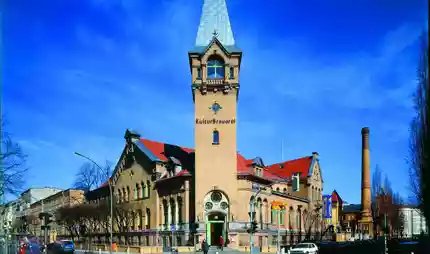
Museum in der Kulturbrauerei
Ideology and reality in the GDR: Museum in der Kulturbrauerei
The Museum in der Kulturbrauerei in Berlin's district of Pankow leads you in the search for traces of day-to-day life in the GDR.
Please note: The current opening and closing hours and special hygiene rules for the Covid-19 are available on this website.
The Museum in der Kulturbrauerei in the Prenzlauer Berg neighbourhood presents 'Everyday life in the GDR'. The permanent exhibition goes on to show the intentions of the GDR regime and the actual lives of people at the time. 800 exhibits and 200 documents, films and sound recordings by contemporary witnesses let you penetrate deeply into the reality of the GDR.
Shortage economy and private happiness
In 1991, the Kulturbrauerei is established at the old Schultheiss brewery on Knaackstraße. The 20 renovated buildings house cinemas, theatres and clubs. In 2005, the Foundation Haus der Geschichte acquires this extensive collection of industrial design and everyday culture from the GDR. Having selected the former brewery as a venue, the opening exhibition 'Everyday life in the GDR' is held on an area of 600 m² in late 2012. Visitors learn about the earliest known ideology of the SED State via large propaganda posters and short texts. The influence of the Soviet Union is obvious in the SED's promotion of jobs and leisure activities. Hear recordings of songs which the collective praised, and look at workers' ledgers: a colourful mixture of political slogans and impressions from meetings, such as football matches. The Museum focuses on the lack of everything - the lack of adequate living space, electronic appliances, fruit and vegetables. A contemporary witness complains about the long wait for a shelving unit and a cassette recorder, and another about a Christmas without oranges. Take a look at a typically furnished flat in a prefabricated building. The style of the textiles is also part of the exhibition. Many East Germans find their happiness in private. Marvel at the ingenuity of humans: the roof tent on the 'Trabi' car that sufficed for a holiday in Rugen or Usedom, and the imaginatively constructed holiday homes in the country. Temporary exhibitions on topics such as design in East Germany complement the permanent exhibition.
Previous Next Previous Next Previous NextImpressive installations at the Museum in der Kulturbrauerei
- 'Trabi' car with a roof tent
- Flat with typical furnishings
- A holiday home in the countryside
- A newspaper kiosk with GDR newspapers
- Media stations with exciting details of everyday life in the GDR
Galleries and museums in Prenzlauer Berg

Less than 400 m south of the Kulturbrauerei, the Tête project space opens in 2012 on Schönhauser Allee. The unique feature of the gallery is that the artists curate and finance their projects independently. In this way, Tête offers an interesting cross-section of different styles. From the Kulturbrauerei it's only about ten minutes to Entretempo Kitchen Gallery, an extraordinary place in the Berlin food scene. In the middle of a bright room, you will see a free-standing kitchen. The motto of the Brazilian creator Tainá Guedes is: food is art and art is food. Interaction and communication result from both. Workshops allow you to you bake bread masks, carve musical instruments from vegetables and compose 'popcorn songs'. The Institut für Alles Mögliche is located 1.3 km south-west of the Kulturbrauerei, at Prenzlauer Allee. Don't let the strange name mislead you, as the Institute has a clear mission: to attempt, through experimentation, to find non-commercial niches in art. The finished works are not for sale. The former Prenzlauer Berg Museum has been adopted by the Museum Pankow group, and its permanent exhibition "Alternative drafts - Prenzlauer Berg before, during and after the fall of the Wall" offers interesting facts about the recent history of the former working-class district and its economic and political development. Critics of the wall, who play an important role in the peaceful revolution of 1989, have lived in Prenzlauer Berg before the transition. Dunckerstraße on Helmholtzplatz is one of the most densely populated residential areas of Berlin. Enter house Number 77 and look around. The interior is modest, reflecting its residents' everyday lives around 1900. You can learn about the development of the residential area of Helmholtzplatz, and about daily life in the north-east of Berlin at the time.
Cost and accessibility at the Museum in der Kulturbrauerei
Reach the Museum in der Kulturbrauerei with ease by using public transport. Take either the subway U2 or the tram M1 or M12 to the 'Eberswalder Straße' stop. From there it is only a few minutes walk to the Museum. There is also a car park in the Kulturbrauerei. Admission is free. Guided tours take place on Saturdays and Sundays, whilst group tours must be booked three weeks in advance. There are also numerous educational programmes for individuals and groups.
Find out more about the city’s neighbourhoods with our Going Local Berlin app.
Opening hours
| Tuesday | |
|---|---|
| Wednesday | |
| Thursday | |
| Friday | |
| Saturday | |
| Sunday | |
| Monday closed |










